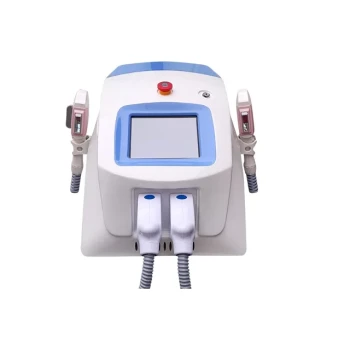For optimal results, Super Hair Removal (SHR) treatments should be performed once a month. This specific interval is designed to maximize effectiveness by allowing your skin adequate time to recover while ensuring the treatment targets hair follicles at the most receptive stage of their growth cycle.
The effectiveness of SHR is not about frequency, but about strategic timing. Adhering to a monthly schedule aligns each session with the hair's natural growth cycle and your skin's recovery process, which is the key to achieving permanent hair reduction.

Why a Monthly Schedule is Critical for SHR
To understand the "once a month" rule, you need to understand the principles behind how SHR works. The timing isn't arbitrary; it's a deliberate strategy based on biology.
Aligning with the Hair Growth Cycle
Hair grows in three main phases: Anagen (active growth), Catagen (transition), and Telogen (resting). SHR technology is only effective when the hair follicle is in the Anagen (active growth) phase, as this is when the follicle is connected to its blood supply, which the light energy targets.
Not all hairs on your body are in the same phase at the same time. A monthly treatment interval is strategically timed to catch the next wave of hair follicles as they enter the Anagen phase, ensuring each session is as effective as possible.
Allowing for Skin Recovery
SHR is known for being gentler than traditional IPL or laser hair removal, but it still delivers thermal energy deep into the skin to destroy hair follicles.
The four-week gap between sessions is crucial for allowing your skin to fully recover and rejuvenate. This minimizes the risk of irritation, inflammation, or other side effects and ensures your skin is in optimal condition for the next treatment.
Maximizing Efficiency and Consistency
The success of your SHR journey is highly dependent on your consistency, especially during the initial series of treatments.
Sticking to a monthly schedule systematically weakens and destroys the hair follicles over time. Missing appointments or extending the gap disrupts this process, which can lead to less effective results and the need for more sessions overall.
Understanding the Consequences of the Wrong Schedule
Deviating from the recommended monthly schedule can undermine your results and, in some cases, pose risks to your skin. Both going too frequently and waiting too long have significant downsides.
The Problem with Treatments Too Close Together
Scheduling sessions less than four weeks apart is counterproductive. The next cycle of hair follicles will not have entered the active growth phase yet, meaning the treatment will be ineffective on them.
More importantly, this over-exposes the skin to heat without sufficient time to heal. This dramatically increases the risk of burns, irritation, and potential long-term issues like hyperpigmentation.
The Problem with Treatments Too Far Apart
If you wait too long between sessions (e.g., 8-12 weeks), you will miss the optimal window to target the next batch of active follicles.
This allows the resting follicles to complete their cycle and re-enter a new growth phase undisturbed. This can significantly slow your progress, effectively requiring you to start over in targeting that hair cycle and extending the total number of sessions needed.
How to Plan Your SHR Journey
Your treatment plan should be based on your goal, whether it's initial reduction or long-term maintenance.
- If your primary focus is achieving the fastest results: Strictly adhere to a once-monthly schedule for the first 6-8 sessions to systematically target all hair growth cycles.
- If your primary focus is long-term maintenance after your initial sessions: You can transition to less frequent touch-ups, typically once every 6 to 12 months, to address any new hair growth.
- If your primary focus is safety and skin health: Never schedule sessions less than four weeks apart to ensure your skin has fully recovered and to minimize any risk of adverse effects.
Ultimately, consistency and patience are your greatest assets in achieving permanently smooth skin with SHR.
Summary Table:
| Schedule | Effectiveness | Risk Level | Recommendation |
|---|---|---|---|
| Too Frequent (< 4 weeks) | Low (misses growth cycle) | High (skin damage, burns) | Avoid |
| Optimal (Once a Month) | High (targets active follicles) | Low (allows skin recovery) | Strongly Recommended |
| Too Infrequent (> 8 weeks) | Low (progress reset) | Low (but slows results) | Not Recommended |
Ready to start your effective and safe SHR journey?
BELIS specializes in providing professional medical aesthetic equipment, including advanced SHR systems, to medical aesthetics clinics and premium beauty salons. Our technology ensures optimal treatment timing, superior patient results, and enhanced clinic efficiency.
Contact BELIS today to learn how our professional SHR equipment can become a cornerstone of your service offerings and drive your business growth.
Visual Guide

Related Products
- Diode Laser SHR Trilaser Hair Removal Machine for Clinic Use
- IPL SHR+Radio frecuency machine
- Clinic Use IPL and SHR Hair Removal Machine with Nd Yag Laser Tattoo Removal
- IPL SHR Hair Removal Machine for Permanent Hair Removal
- Clinic Diode Laser Hair Removal Machine with SHR and Trilaser Technology
People Also Ask
- Which is better, an IPL or a diode laser? Unlock Precision for Permanent Hair Reduction
- What skin type is diode laser for? Safe Hair Removal for Light to Dark Skin
- How effective is diode laser hair removal? Achieve Long-Term Hair Reduction Safely
- Is diode laser effective for hair removal? Achieve Long-Term Hair Reduction with Gold Standard Tech
- Can diode laser remove hair permanently? Achieve Long-Term Hair Reduction with Precision Technology



















